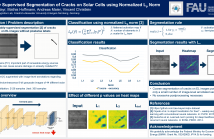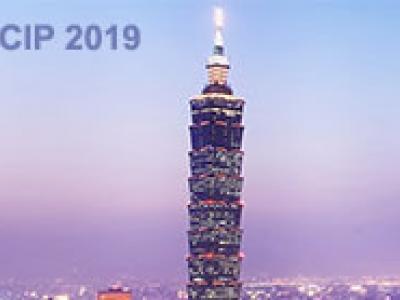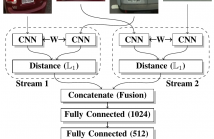
The International Conference on Image Processing (ICIP), sponsored by the IEEE Signal Processing Society, is the premier forum for the presentation of technological advances and research results in the fields of theoretical, experimental, and applied image and video processing. ICIP has been held annually since 1994, brings together leading engineers and scientists in image and video processing from around the world. Visit website.

- Read more about WEAKLY SUPERVISED SEGMENTATION OF CRACKS ON SOLAR CELLS USING NORMALIZED LP NORM
- Log in to post comments
Photovoltaic is one of the most important renewable energy sources for dealing with world-wide steadily increasing energy consumption. This raises the demand for fast and scalable automatic quality management during production and operation. However, the detection and segmentation of cracks on electroluminescence (EL) images of mono- or polycrystalline solar modules is a challenging task. In this work, we propose a weakly supervised learning strategy that only uses image-level annotations to obtain a method that is capable of segmenting cracks on EL images of solar cells.
- Categories:
 18 Views
18 Views
- Read more about Photorealistic Image Synthesis for Object Instance Detection
- Log in to post comments
We present an approach to synthesize highly photorealistic images of 3D object models, which we use to train a convolutional neural network for detecting the objects in real images. The proposed approach has three key ingredients: (1) 3D object models are rendered in 3D models of complete scenes with realistic materials and lighting, (2) plausible geometric configuration of objects and cameras in a scene is generated using physics simulation, and (3) high photorealism of the synthesized images is achieved by physically based rendering.
- Categories:
 19 Views
19 Views
- Read more about MULTIMODAL LATENT FACTOR MODEL WITH LANGUAGE CONSTRAINT FOR PREDICATE DETECTION
- Log in to post comments
poster-2.pdf
- Categories:
 15 Views
15 Views
- Read more about Automatic Motion-blurred Hand Matting for Human Soft Segmentation in Videos
- Log in to post comments
Accurate hand segmentation is important for human segmentation. However, in videos, hand regions usually have serious motion blur, which reduces segmentation performance obviously. To solve this problem, we propose an automatic matting network to deal with motion-blurred hands. Then we combine the hand alpha mattes provided by matting network and the human segmentation results provided by segmentation network to generate our final human soft segmentation results.
- Categories:
 24 Views
24 Views
- Read more about Hyperspectral Image Classification with Tensor-Based Rank-R Learning Models
- Log in to post comments
- Categories:
 20 Views
20 Views
- Read more about TEXTURE-BASED REGION TRACKING USING GAUSSIAN MARKOV RANDOM FIELDS FOR CILIA MOTION ANALYSIS
- Log in to post comments
Region tracking becomes a challenging problem at the presence of low contrast and textured images such as cilia video images where beating cilia appear as moving texture. Tracking such patterns requires extracting of features that are capable of discriminating them effectively. In this paper, a method based on texture features for region tracking is proposed. The texture features are extracted from a sequence of images using Gaussian Markov Random Fields (GMRF). These features are employed to track the motion of a given region and extract its trajectory.
- Categories:
 14 Views
14 Views
- Read more about Face Recognition with Disentangled Facial Representation Learning and Data Augmentation
- Log in to post comments
We address two issues for tackling face recognition across pose, one is disentangled representation learning and the other is training data augmentation. To have better training properties, we propose the Representation-Learning Wasserstein-GAN (RL-WGAN) with three component networks for learning the disentangled facial representation. As the learning based on imbalanced data often leads to biased estimation, we proposed a data augmentation scheme that exploits the 3D Morphable Model (3DMM) for generating faces of desired poses.
- Categories:
 69 Views
69 Views
- Read more about Multimodal Point Distribution Model for Anthropological Landmark Detection
- Log in to post comments
While current landmark detection algorithms offer a good approximation of the landmark locations, they are often unsuitable for the use in biological research. We present multimodal landmark detection approach, based on Point distribution model that detects a larger number of anthropologically relevant landmarks than the current landmark detection algorithms.
At the same time we show that improving detection accuracy of initial vertices, using image information, to which
- Categories:
 38 Views
38 Views
- Read more about A TWO-STREAM SIAMESE NEURAL NETWORK FOR VEHICLE RE-IDENTIFICATION BY USING NON-OVERLAPPING CAMERAS
- Log in to post comments
We describe in this paper a Two-Stream Siamese Neural Network for vehicle re-identification. The proposed network is fed simultaneously with small coarse patches of the vehicle shape’s, with 96 × 96 pixels, in one stream, and fine features extracted from license plate patches, easily readable by humans, with 96 × 48 pixels, in the other one.
ICIP 2019.pdf
- Categories:
 14 Views
14 Views
- Read more about Fast Adaptive Bilateral Filtering of Color Images
- Log in to post comments
The bilateral filter is popularly used for image enhancement. By using a range kernel along with a spatial kernel, the filter is able to smooth images without excessive blurring of edges. It has been shown that the enhancement capacity of the filter can be boosted by adapting the width of the range kernel at each pixel. A fast algorithm for grayscale images was recently proposed for this so-called adaptive bilateral filter, which is otherwise computationally expensive. This can trivially be extended for color filtering using channelwise processing.
slides.pdf
- Categories:
 43 Views
43 Views